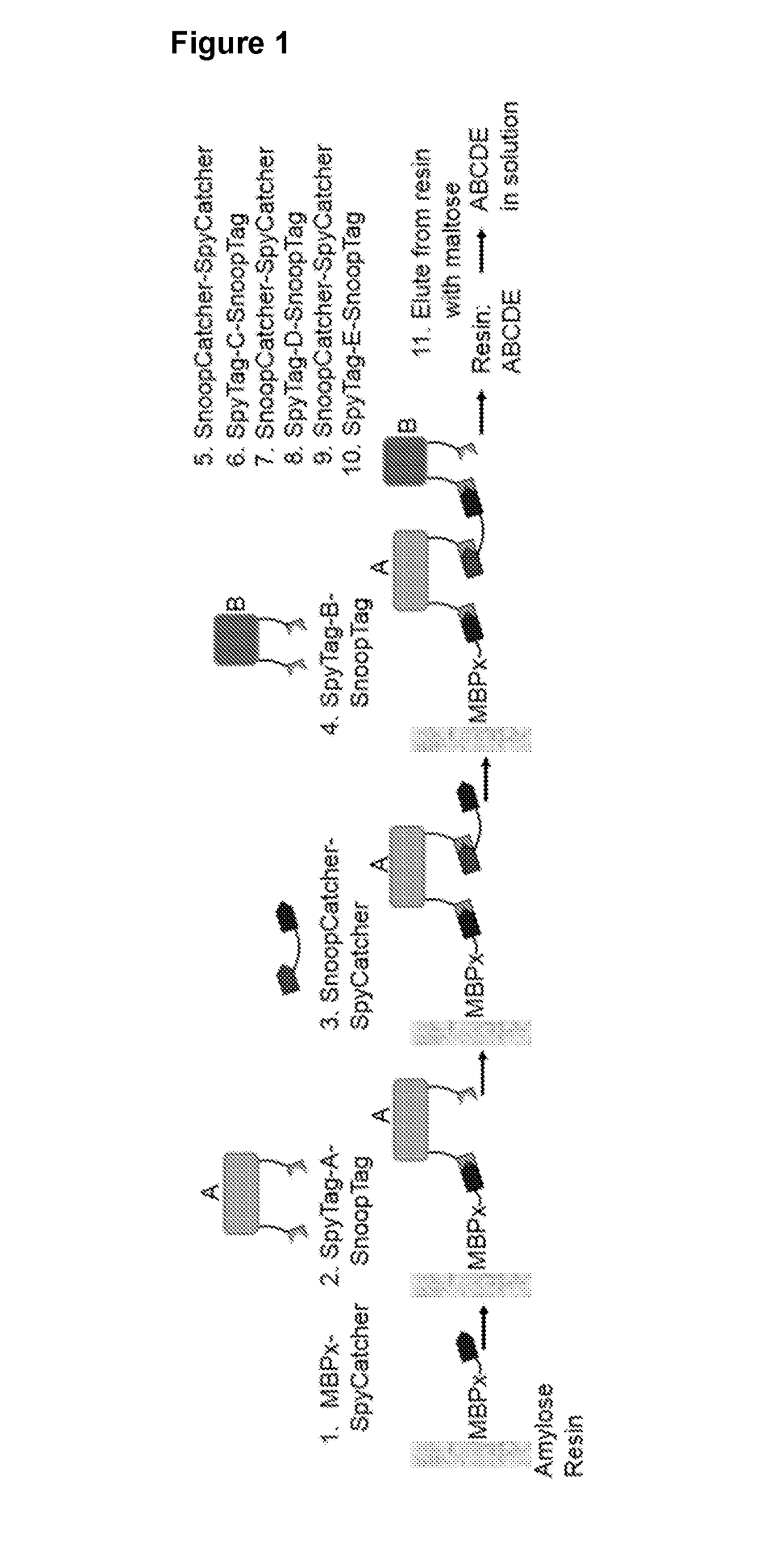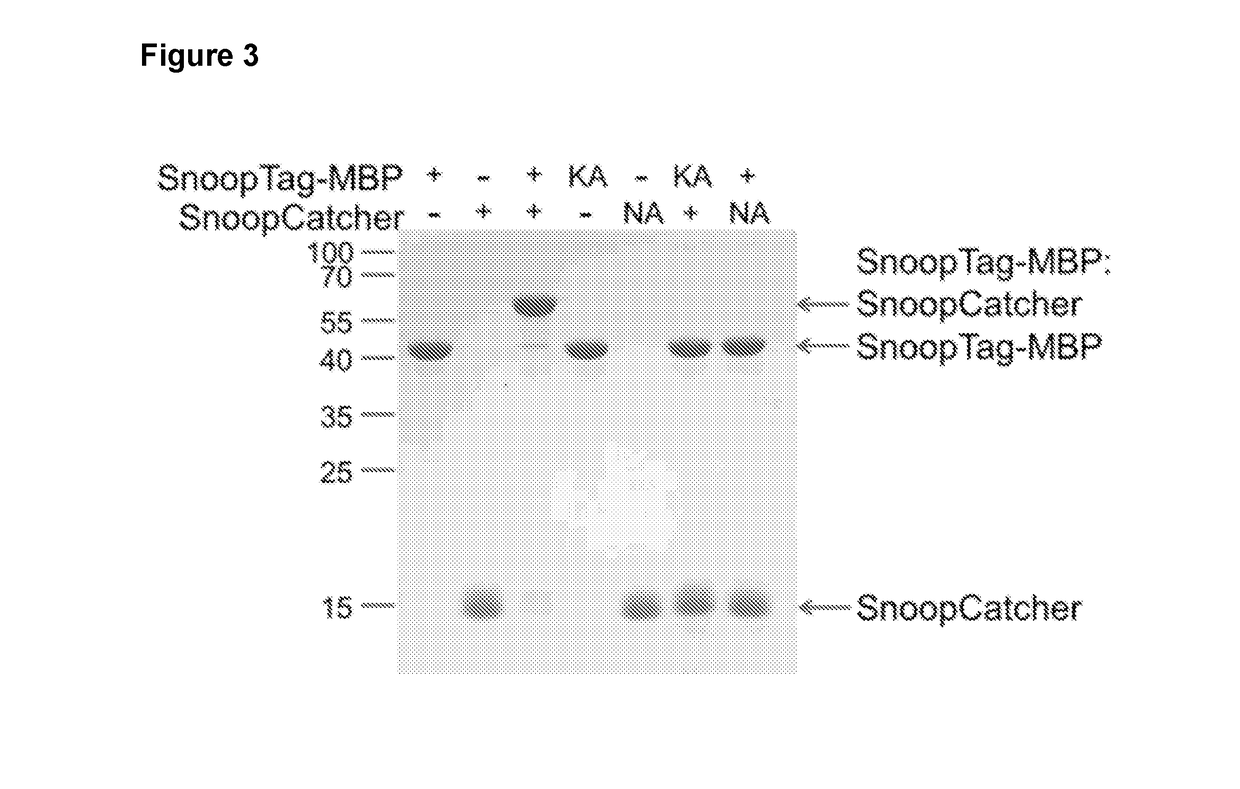Methods and Products for Fusion Protein Synthesis
a technology of fusion protein and protein synthesis, which is applied in the field of methods and products for fusion protein synthesis, can solve the problems of limiting existing methods, errors in protein synthesis and misfolding, and numerous problems in clustering different kinds of proteins into precise artificial “fusion proteins” , to achieve the effect of simple and scalable method and high yield
- Summary
- Abstract
- Description
- Claims
- Application Information
AI Technical Summary
Benefits of technology
Problems solved by technology
Method used
Image
Examples
example 1
d Synthesis of Cognate Pairs of Peptide Linkers that Form Spontaneous Isopeptide Bonds
[0270]RrgA (SEQ ID NO: 21) is an adhesin from Streptococcus pneumoniae, a Gram-positive bacterium which can cause septicaemia, pneumonia and meningitis in humans. A spontaneous isopeptide bond forms in the D4 immunoglobulin-like domain of RrgA between residues Lys742 and Asn854 (FIG. 2). The inventor split the D4 domain into a pair of peptide linkers termed SnoopTag (residues 734-748, SEQ ID NO: 1) and a protein which we named SnoopCatcher (residues 749-860, SEQ ID NO: 2).
[0271]However, the inventors founds that it was necessary introduce two mutations in to the SnoopCatcher peptide linker in order to form a stable pair of peptide linkers for use in the invention. In this respect, the inventor introduced the G842T mutation in SnoopCatcher to stabilize a β-strand and the D848G to stabilize a hairpin turn close to the reaction site.
[0272]The SnoopTag peptide was expressed as a recombinant polypeptide...
example 2
ting the Cross-Reactivity of Pairs of Peptide Linkers
[0278]A peptide tag and binding partner, SpyTag and SpyCatcher (SEQ ID NOs: 13 and 14), that react spontaneously to form an isopeptide bond have been developed previously (WO2011 / 098772).
[0279]SnoopTag has a reactive Lys, whereas SpyTag has a reactive Asp, so the inventor hypothesized that the SnoopTag / SnoopCatcher and SpyTag / SpyCatcher pairs would be fully orthogonal, i.e. would not show cross-reactivity. Upon mixing the peptide linkers in various combinations, it was found that each cognate pair of peptide linkers reacted efficiently, but found no trace of cross-reaction between pairs was found, even after overnight incubation (FIG. 7). This result confirmed that the SnoopTag / SnoopCatcher pair is orthogonal to SpyTag / SpyCatcher.
[0280]The inventor also tested the PsCsTag / PsCsCatcher pair and RrgATag / RrgACatcher pair for cross-reactivity with the SnoopTag / SnoopCatcher and SpyTag / SpyCatcher pairs. As shown in FIG. 8, parts A and B,...
example 3
of Fusion Proteins Using Two Orthogonal Pairs of Peptide Linkers
[0281]The inventors used the “Spy” and “Snoop” pairs of peptide linkers to demonstrate that such orthogonal pairs of peptide linkers can be used successfully to synthesise fusion proteins.
[0282]The interaction of E. coli MBP with amylose resin is widely used in affinity purification: MBP-fusions typically fold and express well and show low non-specific resin binding. MBP shows selective mild elution using maltose, avoiding need for protease removal. The affinity of wild-type MBP for maltose is 1.2 μM, which is practical for protein purification but insufficient for multiple rounds of washing and chain extension in fusion protein synthesis. Therefore, the inventors developed a mutated MBP to improve its maltose-binding stability. Firstly, the inventors modified the polypeptide sequence by introducing mutations A312V and 1317V and deleting residues 172, 173, 175 and 176). Secondly, the MBP mutant (SEQ ID NO: 70) was tande...
PUM
| Property | Measurement | Unit |
|---|---|---|
| temperature | aaaaa | aaaaa |
| temperature | aaaaa | aaaaa |
| temperature | aaaaa | aaaaa |
Abstract
Description
Claims
Application Information
 Login to View More
Login to View More - R&D
- Intellectual Property
- Life Sciences
- Materials
- Tech Scout
- Unparalleled Data Quality
- Higher Quality Content
- 60% Fewer Hallucinations
Browse by: Latest US Patents, China's latest patents, Technical Efficacy Thesaurus, Application Domain, Technology Topic, Popular Technical Reports.
© 2025 PatSnap. All rights reserved.Legal|Privacy policy|Modern Slavery Act Transparency Statement|Sitemap|About US| Contact US: help@patsnap.com



